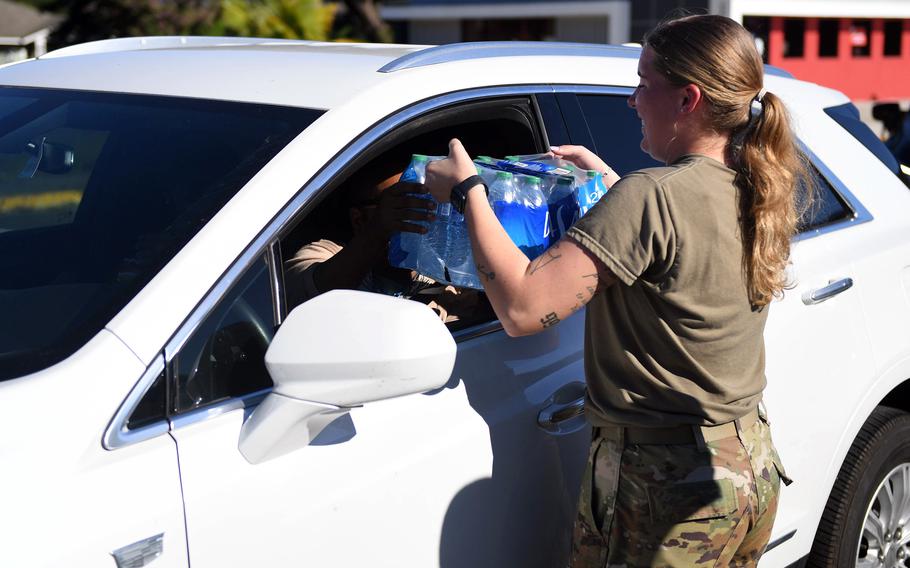
Army Cpl. Alexandria Ayotte passes out water to residents of Aliamanu Military Reserve, Feb. 3, 2022, in the wake of tap water contamination from the Red Hill Bulk Fuel Storage Facility near Joint Base Pearl Harbor-Hickam, Hawaii. ()
The best hope of tracking and investigating short- and long-term health effects of people exposed to the 2021 Red Hill jet fuel leak in Hawaii is the establishment of an independently operated registry, a physician with the Defense Health Agency said Tuesday.
But, more than two years after the spill that contaminated the Navy’s drinking water system used by thousands, such a registry remains a work in progress, Col. John Oh, chief of the occupational and environmental health division with the Defense Health Agency, said during a webinar Tuesday.
“It should have been operational like a year ago; I wish it could have been,” said Oh, who prefaced his remarks by saying they reflected his opinions, not those of the agency or the Defense Department.
“[T]he most important reason for enrolling in the registry is that it’s the best means to study the long-term health impacts from the fuel release,” said Oh, calling the contamination “an open public-health investigation.”
“We want to partner with those exposed to the fuel release to help get answers,” he said. “Public health investigations can take time, and this can be frustrating.”
Oh offered no timeline for when the registry could possibly open for enrollment by those who experienced consequences of the fuel spill. “I couldn’t say for sure at this point,” he said.
Shortly after the contamination, the Navy established the Red Hill Defense Occupational and Environmental Health Readiness System Incident Report, a database of service members and their family members living in military communities affected by the spill.
The DHA describes this database on its website as “Registry 1.0.” It cannot receive or store individual health questionnaires as planned for in the upcoming registry.
Thousands of residents in military housing communities on and near Joint Base Pearl Harbor-Hickam were relocated in the months after the November 2021 water contamination as the Navy flushed the distribution system.
Some complained of a host of conditions, such as rashes, headaches, nausea, dizziness and vomiting. Scores have joined a lawsuit filed in federal court seeking compensation.
Anyone potentially exposed to the contamination would be eligible to enroll in the registry, regardless of whether they had any connection to the military.
The registry would track health over time, investigate health effects of exposure and provide information and support, according to the DHA’s website.
Oh spent most of the hourlong webinar fielding written questions submitted by people who were affected by the contamination.
He invariably returned to the registry each time he was asked about how best to assess symptoms or conditions arising from exposure.
For example, one questioner asked how infants and children would be affected after exposure to tainted water that had been used for cooking or washing clothes.
“I think the answer is that we don’t have any specific information on infants and children and whether they will differ from adults in terms of the type of symptoms they experience acutely,” he said.
Many parents are concerned about possible long-term developmental effects on children exposed to the contaminated water, Oh said.
“And again, I think that’s why we really need to have this independent Red Hill registry,” he said. “I encourage everyone, particularly parents, to enroll everyone in your family into the independent Red Hill registry because we really need to … try to understand this particular issue.”
DHA is working with the Agency for Toxic Substances and Disease Registry under the Department of Health and Human Services to develop the registry.
“We are planning for the registry to be a grant to an independent organization, such as a university,” he said. “The beneficiary of a grant is the community, and that’s different than a contract, which serves the interests of the agency that sponsored the contract.”